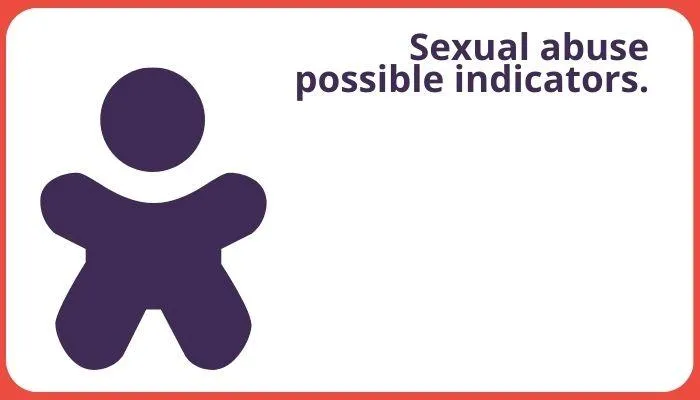Every child's well-being matters.
Types of Abuse Articles
Quick Access
Abuse of Authority
Abuse of Discretion
Abuse of Power
Behavioural Indications
Breast Ironing
County Lines
Cultural Differences (Physical Abuse)
Domestic Abuse
Economic Abuse
Emotional Signs
Exposure to Substance Abuse
Failure to Thrive
Female Genital Mutilation (FGM)
Forced Marriage
Hate Crimes & Targeted Harassment
Impact of Domestic Violence
Impact of Environment
Impact on Development
Institutional Abuse
Isolation
Modern Slavery
Neglect
Online Abuse
Parental Behaviours
Physical Abuse
Radicalisation
Religious Abuse
Restraint
Sexual Abuse
Types of Abuse
Witnessing Domestic Abuse

What are the signs of sexual abuse
Recognising signs of sexual abuse is crucial as it is a serious and sensitive issue with profound impacts on individuals. While these signs do not confirm abuse definitively, they may serve as indicators that someone requires help and support. This is true for both children and adults alike.
Behavioural and Mood Changes:
Sudden shifts in behaviour, mood, or personality, such as increased fear, anxiety, or depression.
Withdrawal from friends and family or engaging in new, unusual activities.
Sexual Knowledge and Behavior:
Displaying knowledge of sexual matters that seem too mature for their age.
Playing in overly grown-up ways or creating drawings that may cause discomfort.
Difficulty Trusting and Forming Relationships:
Difficulty trusting others or forming close emotional bonds.
Fear of physical contact or emotional closeness with others.
Impact on Developmental Milestones:
Regressing in milestones, such as toilet accidents when being dry and difficulty paying attention that is markedly different what you would expect developmentally.
Physical Signs:
Unexplained pain, bleeding, or injuries in private areas.
Infections related to sexual activity.
Emotional Distress:
Feeling upset, having nightmares, or constant preoccupation with a traumatic event.
Avoidance Behavior:
Avoidance of specific people, places, or activities that serve as reminders of the abuse.
Self-Harm or Suicidal Thoughts:
Engaging in self-harming behaviours or expressing thoughts of self-harm or suicide.
Inappropriate Sexual Knowledge:
Talking about or possessing knowledge of sexual matters that are inappropriate for their age.
Changes in Personal Care Habits:
Excessive washing or neglecting personal care indicates a shift in self-care habits.
It's essential to note that observing these signs in someone does not automatically confirm sexual abuse. However, taking these indicators seriously and reaching out for help is crucial when building a picture of safeguarding concerns.
AUTHOR:- Iona has nearly 10 years of experience supporting nurseries and childminders in curriculum planning, leadership, and safeguarding. Her writing is informed by public information and sector insight, aiming to provide accessible, practical support for professionals working with children. She is part of the On the Button team, helping deliver Well-being, Safeguarding and Complaint Management Software that empowers practitioners to identify concerns early and act confidently.
On the Button provides innovative software tailored to the needs of the early years sector, with a strong focus on EYFS well-being and early years safeguarding. Our tools help senior practitioners to confidently track concerns, maintain robust records, and respond effectively — all while meeting statutory guidance. From early years complaint management to team-wide safeguarding alerts, our platform puts children's safety and emotional health first.
Quick Access
Abuse of Authority
Abuse of Discretion
Abuse of Power
Behavioural Indications
Breast Ironing
County Lines
Cultural Differences (Physical Abuse)
Domestic Abuse
Economic Abuse
Emotional Signs
Exposure to Substance Abuse
Failure to Thrive
Female Genital Mutilation (FGM)
Forced Marriage
Hate Crimes & Targeted Harassment
Impact of Domestic Violence
Impact of Environment
Impact on Development
Institutional Abuse
Isolation
Modern Slavery
Neglect
Online Abuse
Parental Behaviours
Physical Abuse
Radicalisation
Religious Abuse
Restraint
Sexual Abuse
Types of Abuse
Witnessing Domestic Abuse

What are the signs of sexual abuse
Recognising signs of sexual abuse is crucial as it is a serious and sensitive issue with profound impacts on individuals. While these signs do not confirm abuse definitively, they may serve as indicators that someone requires help and support. This is true for both children and adults alike.
Behavioural and Mood Changes:
Sudden shifts in behaviour, mood, or personality, such as increased fear, anxiety, or depression.
Withdrawal from friends and family or engaging in new, unusual activities.
Sexual Knowledge and Behavior:
Displaying knowledge of sexual matters that seem too mature for their age.
Playing in overly grown-up ways or creating drawings that may cause discomfort.
Difficulty Trusting and Forming Relationships:
Difficulty trusting others or forming close emotional bonds.
Fear of physical contact or emotional closeness with others.
Impact on Developmental Milestones:
Regressing in milestones, such as toilet accidents when being dry and difficulty paying attention that is markedly different what you would expect developmentally.
Physical Signs:
Unexplained pain, bleeding, or injuries in private areas.
Infections related to sexual activity.
Emotional Distress:
Feeling upset, having nightmares, or constant preoccupation with a traumatic event.
Avoidance Behavior:
Avoidance of specific people, places, or activities that serve as reminders of the abuse.
Self-Harm or Suicidal Thoughts:
Engaging in self-harming behaviours or expressing thoughts of self-harm or suicide.
Inappropriate Sexual Knowledge:
Talking about or possessing knowledge of sexual matters that are inappropriate for their age.
Changes in Personal Care Habits:
Excessive washing or neglecting personal care indicates a shift in self-care habits.
It's essential to note that observing these signs in someone does not automatically confirm sexual abuse. However, taking these indicators seriously and reaching out for help is crucial when building a picture of safeguarding concerns.
AUTHOR:- Iona has nearly 10 years of experience supporting nurseries and childminders in curriculum planning, leadership, and safeguarding. Her writing is informed by public information and sector insight, aiming to provide accessible, practical support for professionals working with children. She is part of the On the Button team, helping deliver Well-being, Safeguarding and Complaint Management Software that empowers practitioners to identify concerns early and act confidently.
On the Button provides innovative software tailored to the needs of the early years sector, with a strong focus on EYFS well-being and early years safeguarding. Our tools help senior practitioners to confidently track concerns, maintain robust records, and respond effectively — all while meeting statutory guidance. From early years complaint management to team-wide safeguarding alerts, our platform puts children's safety and emotional health first.

What are the signs of sexual abuse
Recognising signs of sexual abuse is crucial as it is a serious and sensitive issue with profound impacts on individuals. While these signs do not confirm abuse definitively, they may serve as indicators that someone requires help and support. This is true for both children and adults alike.
Behavioural and Mood Changes:
Sudden shifts in behaviour, mood, or personality, such as increased fear, anxiety, or depression.
Withdrawal from friends and family or engaging in new, unusual activities.
Sexual Knowledge and Behavior:
Displaying knowledge of sexual matters that seem too mature for their age.
Playing in overly grown-up ways or creating drawings that may cause discomfort.
Difficulty Trusting and Forming Relationships:
Difficulty trusting others or forming close emotional bonds.
Fear of physical contact or emotional closeness with others.
Impact on Developmental Milestones:
Regressing in milestones, such as toilet accidents when being dry and difficulty paying attention that is markedly different what you would expect developmentally.
Physical Signs:
Unexplained pain, bleeding, or injuries in private areas.
Infections related to sexual activity.
Emotional Distress:
Feeling upset, having nightmares, or constant preoccupation with a traumatic event.
Avoidance Behavior:
Avoidance of specific people, places, or activities that serve as reminders of the abuse.
Self-Harm or Suicidal Thoughts:
Engaging in self-harming behaviours or expressing thoughts of self-harm or suicide.
Inappropriate Sexual Knowledge:
Talking about or possessing knowledge of sexual matters that are inappropriate for their age.
Changes in Personal Care Habits:
Excessive washing or neglecting personal care indicates a shift in self-care habits.
It's essential to note that observing these signs in someone does not automatically confirm sexual abuse. However, taking these indicators seriously and reaching out for help is crucial when building a picture of safeguarding concerns.
AUTHOR:- Iona has nearly 10 years of experience supporting nurseries and childminders in curriculum planning, leadership, and safeguarding. Her writing is informed by public information and sector insight, aiming to provide accessible, practical support for professionals working with children. She is part of the On the Button team, helping deliver Well-being, Safeguarding and Complaint Management Software that empowers practitioners to identify concerns early and act confidently.
On the Button provides innovative software tailored to the needs of the early years sector, with a strong focus on EYFS well-being and early years safeguarding. Our tools help senior practitioners to confidently track concerns, maintain robust records, and respond effectively — all while meeting statutory guidance. From early years complaint management to team-wide safeguarding alerts, our platform puts children's safety and emotional health first.
Quality Early Years Ltd.,
Dickens House,
Guithavon Street,
Witham, Essex,
England, CM8 1BJ
© Quality Early Years Ltd 2025
On the Button are Finalists for 3/3 Early Years Awards!
Find On the Button
on Social Media

